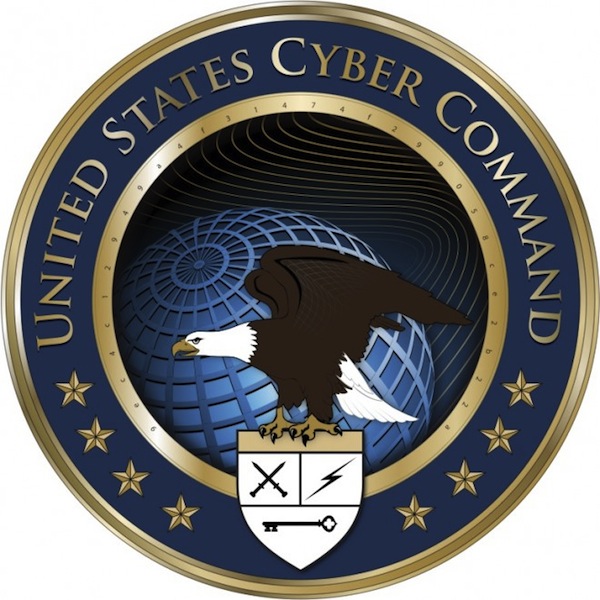 The newly formed U.S. Cyber Command is supposed to centralize and focus the military’s ability to wage war over the Internet, but so far it’s basically famous for brainteasers. The command’s fancy logo contains a super-secret code in its inner gold ring: 9ec4c12949a4f31474f299058ce2b22a. Though some people noticed the code late last month, Wired’s Threat Level Danger Room blog picked it up Wednesday morning and announced a contest, with a free T-shirt (or a ticket to the International Spy Museum)Â going to the first reader to crack the code.
The newly formed U.S. Cyber Command is supposed to centralize and focus the military’s ability to wage war over the Internet, but so far it’s basically famous for brainteasers. The command’s fancy logo contains a super-secret code in its inner gold ring: 9ec4c12949a4f31474f299058ce2b22a. Though some people noticed the code late last month, Wired’s Threat Level Danger Room blog picked it up Wednesday morning and announced a contest, with a free T-shirt (or a ticket to the International Spy Museum)Â going to the first reader to crack the code.
[Would new legislation give the president an “Internet kill switch”?]
Trouble is, no one knows for sure yet precisely what the 32-character code means. Or at least no one at Cyber Command appears to know. Lt. Cmdr. Steve Curry, a spokesman, says “it’s definitely the mission statement” of Cyber Command. “What part of the mission statement: That’s what I’m waiting to find out on from the people who designed it.”
Indeed, the heraldry notes accompanying the logo — i.e., explanations of what the symbols mean — say it contains a “computer code that ties the command back to the early days of computer networking; USCYBERCOM’s mission statement is encrypted within this code.” Curry suspects that the designers used a cryptographic algorithm called an MD5 hash to transform the mission statement into the string of characters, but he doesn’t know whether they took choice bits or the whole statement, which reads:
USCYBERCOM plans, coordinates, integrates, synchronizes, and conducts activities to: direct the operations and defense of specified Department of Defense information networks and; prepare to, and when directed, conduct full-spectrum military cyberspace operations in order to enable actions in all domains, ensure US/Allied freedom of action in cyberspace and deny the same to our adversaries.
[Federal embrace of ‘cloud computing’ scares some experts]
We tried encrypting that entire statement using an MD5 hash generator, and we didn’t get a match to the logo code. So it looks like just a portion of the statement has been encoded. Eventually someone will figure out which portion, and win a T-shirt from Wired — at which point the CIA will laugh at the whole episode, because it still has Kryptos, an encrypted sculpture commissioned on the grounds of its Langley headquarters. The code displayed on Kryptos hasn’t been fully solved in 20 years and contains one of the world’s most elusive cryptographic puzzles. Nice try, Cyber Command!

Code Cracked! Cyber Command Logo Mystery Solved
Okay, maybe it wasn’t that much of a mystery. In fact, it took a little more than three hours for Danger Room reader jemelehill to figure out the odd string of letters and numbers in the logo of the U.S. military’s new Cyber Command. Turns out, it’s the new unit’s mission statement, translated into 32 digits with the md5 cryptographic hash:
USCYBERCOM plans, coordinates, integrates, synchronizes, and conducts activities to: direct the operations and defense of specified Department of Defense information networks and; prepare to, and when directed, conduct full-spectrum military cyberspace operations in order to enable actions in all domains, ensure freedom of action in cyberspace for the U.S. and its allies, and deny the same to adversaries.
Eventually, other commenters figured it out (especially after jemelehill’s solution made it to all the databases of cracked hashes). But that didn’t stop folks from offering their own, shall we say, creative guesses, in order to win one of two coveted prizes: a Danger Room T-shirt or a ticket to the International Spy Museum.
* “If you can read this, send your resume to jobs@nsa.gov.â€
* “I’m sorry, Dave. I’m afraid I can’t do that.â€
* “If the intelligence community is a family, think of us as the uncle no one talks about.â€
* “Darmok and Jalad at Tanagraâ€
* “In God We Trust All Others We Monitorâ€
* “Why do people keep posting the wrong answers when someone solved it like 20 comments ago?â€
